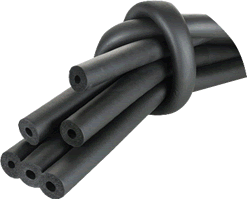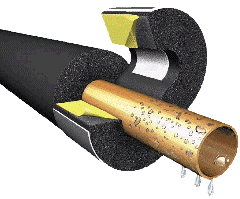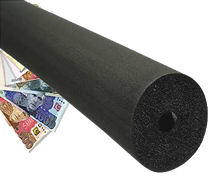V-Flex an "Elastomer pipe insulation" is closed cell, fibre free and hence completely non porous.
V-Flex is made from synthetic rubber with closed cells. It is light, extremely flexible and durable insulation for liquid cooling and heatings lines.
V-Flex is designed to give a fine cellular structure, good thermal efficiency, thus providing excellent insulation and condensation control.
V-Flex is available in popular sizes ranging from nominal wall thickness of 3/8" to 1½".
Download Brochure
Our Products are manufactured on a fully automated and modern plant, ensuring repeated quality and standards.
Extreme Tempretures

Where pipework is operating at extremely high or low temperatures, the potential exists for injury to occur should any person come into physical contact with the pipe surface. The threshold for human pain varies, but several international standards set recommended touch temperature limits.
Since the surface temperature of insulation varies from the temperature of the pipe surface, typically such that the insulation surface has a "less extreme" temperature, V-FLEX pipe insulation can be used to bring surface touch temperatures into a safe range.
Temperature Range:
-57°C (70°F) to +125°C (275°F)
Condensation Control

Where pipes operate at below-ambient temperatures, the potential exists for water vapour to condense on the pipe surface. Moisture is known to contribute towards many different types of corrosion, so preventing the formation of condensation on pipework is usually considered important.
V-FLEX Pipe insulation can prevent condensation forming, as the surface temperature of the insulation will vary from the surface temperature of the pipe. Condensation will not occur, provided that (a) the insulation surface is above the dewpoint temperature of the air; and (b) the insulation incorporates some form of water-vapour barrier or retarder that prevents water vapour from passing through the insulation to form on the pipe surface
Energy Saving

Since pipework can operate at temperatures far removed from the ambient temperature, and the rate of heat flow from a pipe is related to the temperature differential between the pipe and the surrounding ambient air, heat flow from pipework can be considerable. In many situations, this heat flow is undesirable. The application of thermal pipe insulation introduces thermal resistance and reduces the heat flow.
Thicknesses of V-FLEX pipe insulation used for saving energy vary, but as a general rule, pipes operating at more-extreme temperatures exhibit a greater heat flow and larger thicknesses are applied due to the greater potential savings.

